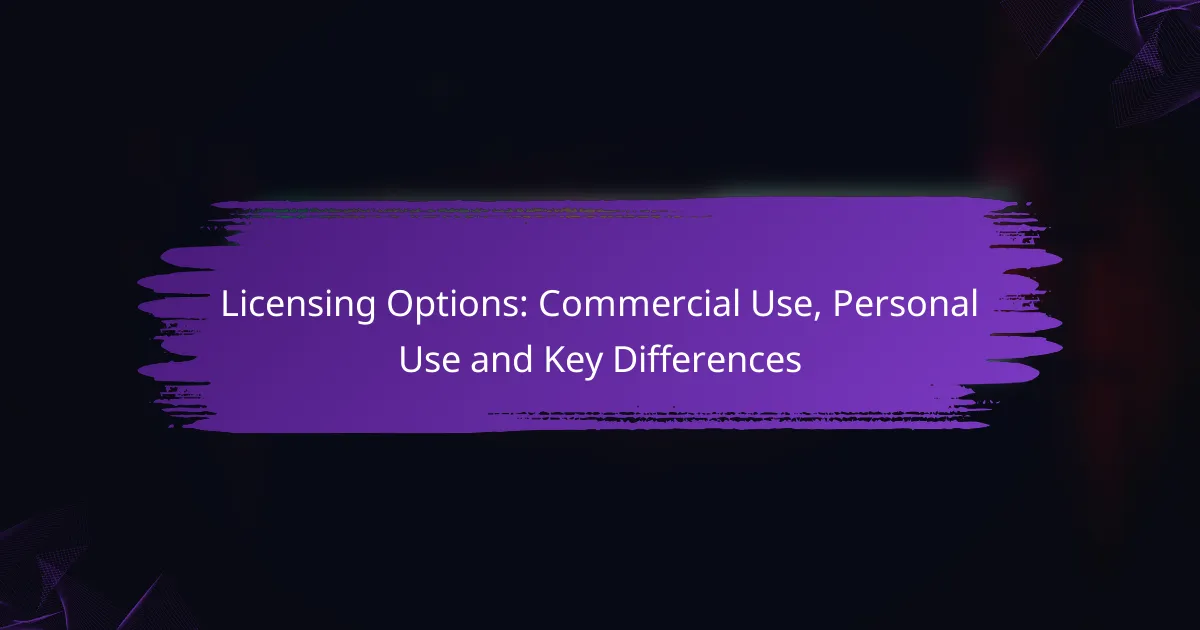Understanding licensing options is essential for anyone looking to use licensed material, whether for commercial or personal purposes. Commercial use licenses enable profit-driven activities, while personal use licenses limit usage to non-commercial contexts. Each type comes with specific terms that dictate how the material can be utilized, making it crucial to grasp these differences for compliance and appropriate use.

What are the licensing options for commercial use in the US?
In the US, licensing options for commercial use typically include standard commercial licenses, extended commercial licenses, and royalty-free commercial licenses. Each type has its own terms and conditions that dictate how the licensed material can be used in business contexts.
Standard commercial license
A standard commercial license allows businesses to use licensed materials for a variety of commercial purposes, such as advertising, marketing, and product packaging. This type of license usually includes limitations on the number of copies or the geographical area where the material can be used.
When considering a standard commercial license, it is essential to review the specific terms, as they can vary significantly between providers. For instance, some licenses may restrict usage to a certain number of products or require additional fees for higher distribution volumes.
Extended commercial license
An extended commercial license offers broader usage rights compared to a standard license. This type of license typically allows for unlimited distribution and may include additional rights, such as the ability to modify the licensed material.
Businesses that anticipate high-volume sales or extensive distribution should consider an extended commercial license. While it may come at a higher upfront cost, it can be more economical in the long run if the material will be used widely across various platforms or products.
Royalty-free commercial license
A royalty-free commercial license permits the use of licensed materials without ongoing royalty payments. Once purchased, users can utilize the material in their projects without incurring additional costs for each use.
This type of license is particularly appealing for businesses with tight budgets or those that require frequent use of specific assets. However, it is crucial to check the license terms, as some royalty-free licenses may have restrictions on resale or require attribution.

What are the licensing options for personal use in the US?
In the US, personal use licensing options primarily include standard personal licenses and Creative Commons personal licenses. Each type has specific terms that dictate how you can use the licensed material, so understanding the differences is crucial for compliance.
Standard personal license
A standard personal license typically allows individuals to use a product for non-commercial purposes. This means you can enjoy the content privately, but you cannot sell or distribute it without permission.
When obtaining a standard personal license, check the specific terms, as they can vary by provider. Some licenses may allow modifications, while others may restrict usage to the original format. Always read the fine print to avoid unintentional violations.
Creative Commons personal license
Creative Commons licenses offer a flexible range of protections and freedoms for creators and users. These licenses can vary widely, from allowing any type of use with attribution to more restrictive options that limit modifications or commercial use.
When using content under a Creative Commons personal license, ensure you comply with the specific conditions outlined, such as providing proper attribution or not using the material for commercial purposes. Familiarize yourself with the different types of Creative Commons licenses to choose the one that best fits your needs.
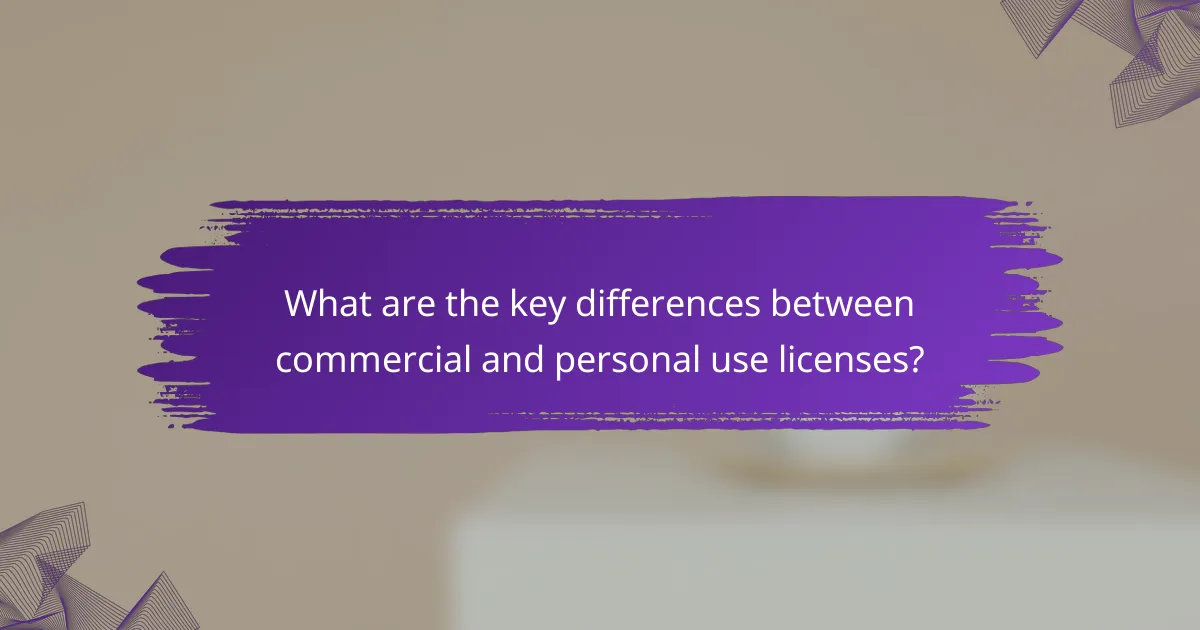
What are the key differences between commercial and personal use licenses?
The primary difference between commercial and personal use licenses lies in the intended application of the licensed material. Commercial use licenses allow for profit-driven activities, while personal use licenses restrict usage to non-commercial, private purposes.
Usage rights comparison
Commercial use licenses grant broader rights, enabling users to incorporate the material into products, services, or promotional content that generates revenue. In contrast, personal use licenses limit the application to personal projects, such as home use or sharing with friends, without any financial gain.
For example, a commercial license might allow a graphic designer to use stock images in a client’s advertisement, while a personal license would only permit the designer to use those images for a personal blog or social media post.
Cost implications
Typically, commercial use licenses are more expensive than personal use licenses due to the potential for profit generation. Prices can vary widely, often ranging from moderate fees for basic licenses to significantly higher costs for exclusive rights.
For instance, a stock photo might cost around $10 for personal use but could be priced at $100 or more for commercial use, depending on the intended application and distribution scale.
Attribution requirements
Attribution requirements can differ significantly between license types. Many personal use licenses require users to credit the creator, while commercial licenses may not have such stipulations, allowing for more flexibility in branding and marketing.
However, some commercial licenses may still require attribution if specified in the terms, so it’s essential to review the license agreement carefully to avoid any compliance issues.
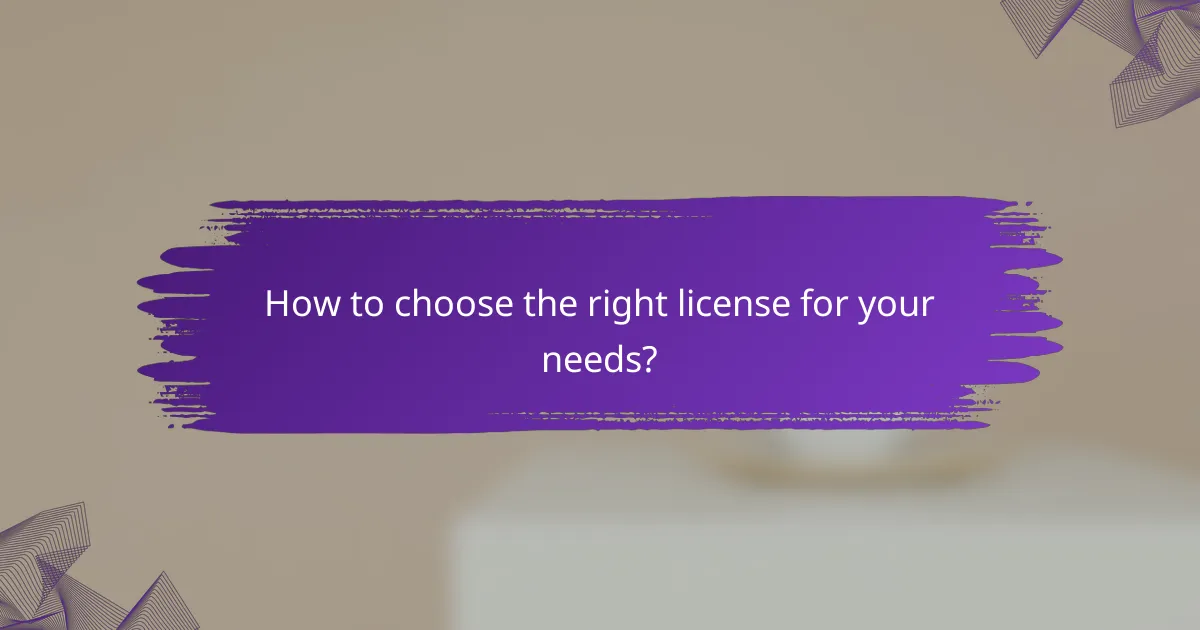
How to choose the right license for your needs?
Choosing the right license for your needs involves understanding the differences between commercial and personal use licenses. Consider the nature of your project and how you intend to use the licensed material to make an informed decision.
Assessing your project requirements
Start by clearly defining the scope of your project. Are you using the material for a personal blog, or is it for a commercial product? Commercial use typically requires a more comprehensive license that allows for profit generation, while personal use may suffice for non-profit endeavors.
Evaluate the specific features you need from the license. For instance, some licenses may restrict modifications or require attribution, which could impact your project’s direction. Make a checklist of essential features to guide your selection process.
Understanding your audience
Knowing your audience is crucial when selecting a license. If your project targets businesses or commercial entities, a commercial license is often necessary to meet their expectations and legal requirements. Conversely, if your audience is primarily individuals or hobbyists, a personal use license may be adequate.
Consider how your audience will interact with the licensed material. If they will share or modify it, ensure the license allows for such actions. Engaging with your audience’s needs can help you choose a license that fosters community and collaboration while protecting your rights.
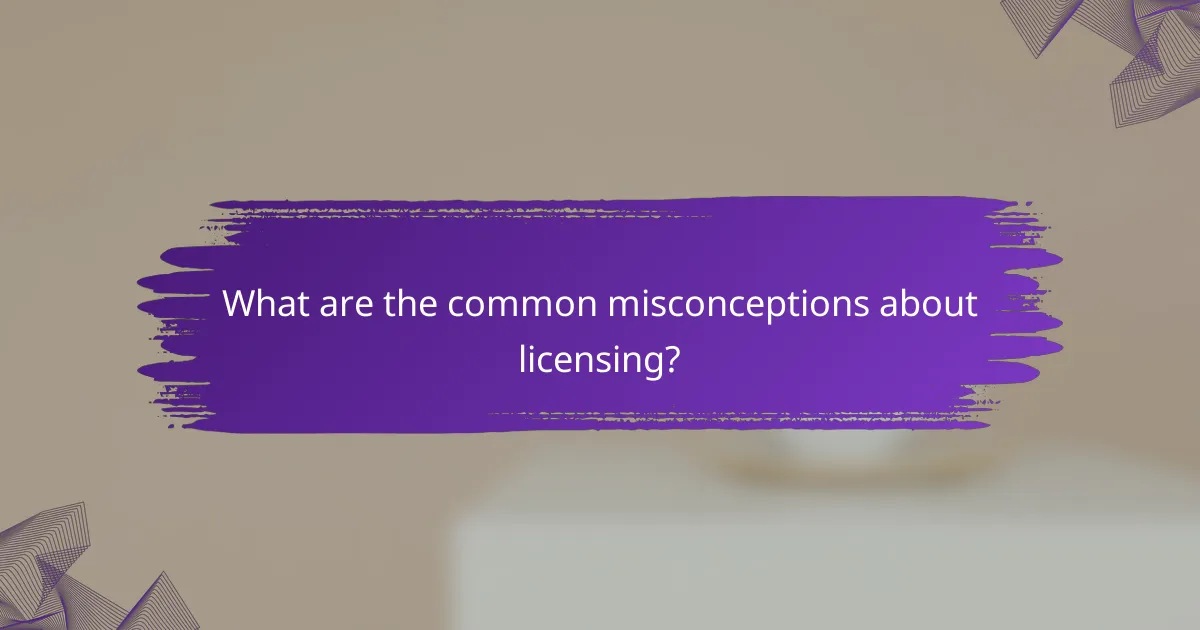
What are the common misconceptions about licensing?
Many people misunderstand the nuances of licensing, particularly regarding commercial and personal use. These misconceptions can lead to improper usage of licensed materials, resulting in legal issues or financial penalties.
Misunderstanding commercial vs personal use
Commercial use typically refers to using licensed materials for business purposes, which can include selling products, advertising, or generating revenue. Personal use, on the other hand, is limited to non-commercial activities, such as private projects or personal enjoyment.
For example, using a stock photo in a marketing campaign constitutes commercial use, while using the same photo as a desktop wallpaper falls under personal use. Understanding these distinctions is crucial to avoid unintentional violations of licensing agreements.
Assuming all licenses are the same
Not all licenses are created equal; they vary significantly in terms of rights and restrictions. Some licenses may allow for modifications and redistribution, while others strictly prohibit these actions.
For instance, a Creative Commons license may permit certain uses with attribution, whereas a proprietary license might limit usage to specific applications. Always read the terms of a license carefully to understand what is permissible.
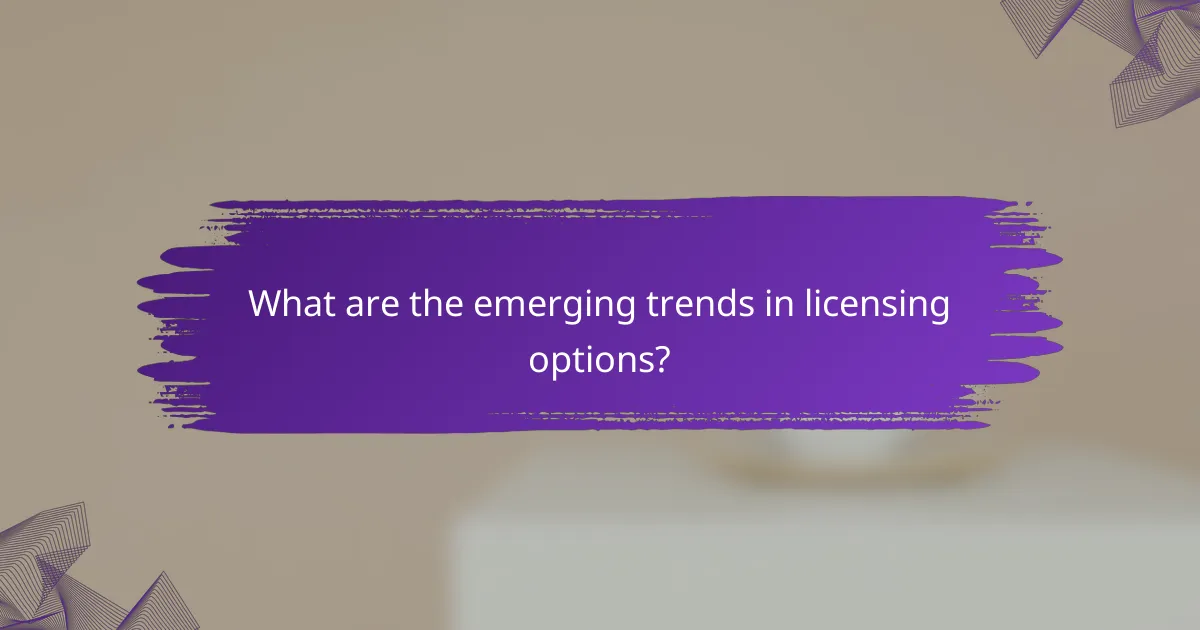
What are the emerging trends in licensing options?
Emerging trends in licensing options reflect a shift towards more flexible and user-friendly models, catering to both commercial and personal use. These trends include the growth of subscription-based licenses and increased flexibility in licensing terms, which provide users with more choices and adaptability in how they utilize licensed materials.
Growth of subscription-based licenses
Subscription-based licenses are becoming increasingly popular, allowing users to access a range of products or services for a recurring fee. This model often suits businesses and individuals who prefer lower upfront costs and the ability to scale usage based on needs.
For example, software companies frequently offer monthly or annual subscriptions, enabling users to stay updated with the latest features without significant initial investments. This trend is particularly beneficial for startups and freelancers who may have fluctuating demands.
Increased flexibility in licensing terms
Licensing terms are evolving to become more adaptable, catering to different user scenarios and preferences. This flexibility can include options for limited-time use, tiered pricing based on usage, or the ability to switch between personal and commercial licenses as needed.
For instance, a stock photo service might allow users to purchase images for personal use at a lower rate, with the option to upgrade to a commercial license if the images are needed for business purposes. This adaptability helps users avoid unnecessary costs while ensuring compliance with licensing agreements.
